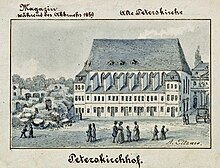Kornhaus (Leipzig)
The granary , in the 19th century, magazine , was named for Leipzig the central municipal storehouse for grain and other goods.
Location and shape
The Kornhaus was located on the southern border of Leipzig's old town at the end of the Neumarkt (until 1839 Neuer Neumarkt). At the beginning it stood directly on the inside of the double city wall. The immediate western neighbor was the Alte Peterskirche . At the eastern end of the Kornhaus, the high tower , also called Lands-Krone , stood in the city wall until it was demolished . North of the Kornhaus ran the Magazingasse, so named in 1839 (formerly Stadtpfeifer- , Häscher- (police) or also Wehmütter- (midwives) alleys, as these professions lived across from the Kornhaus).
The granary was a massive building with six floors, three of which were bulk floors under the steep gable roof . While these were intended for the storage of grain, the lower ones were used for storing building materials, coal and other things. The hearse and water syringes for fire fighting were also here. A water reserve was also kept for the city. These 500 barrels of water were also called the water treasure.
history
The granary was built between 1523 and 1529. In the more than 400 years of its existence it has hardly been changed apart from the repair of war damage and old age.
His surroundings are different. In the 1770s, the removal of the city walls and other fortifications began. This meant that south of the Kornhaus at the Zwinger , the area between the two city walls, space was created for residential houses and along the dry city moat for a footpath, the Moritzdamm. The latter led from the Peterstor past the community school on the former Moritzbastei to the Grimmaischer Tor .
The next redesign of the southern edge of the city took place in the 1850s, to which the Kornhaus, now known as the magazine, fell victim. In 1857, the Royal Prussian Garden Director Peter Joseph Lenné received the order to design a park between Augustusplatz and Peterstor. He had the city moat backfilled and designed the Schiller Park, now the Lenné plant . To the north of the park, Schillerstraße was built along Moritzdamm. The park and street were handed over on the 100th birthday of Friedrich Schiller on November 10, 1859. The granary was demolished in 1857 in order to gain construction freedom for the representative residential and commercial buildings on the north side of Schillerstrasse, which were built between 1860 and 1863 and are now under monument protection .
Another granary
A second building called the Kornhaus existed for a short time in Leipzig. It was built in 1545 according to plans by Hieronymus Lotter on the corner of Brühl and Ritterstrasse. The multi-storey building served the guilds of butchers, tanners, blacksmiths and shoemakers as a granary until 1557, before the city council set up the municipal hay and flax scale here.
literature
- Horst Riedel, Thomas Nabert (ed.): Stadtlexikon Leipzig from A to Z . 1st edition. Pro Leipzig, Leipzig 2005, ISBN 3-936508-03-8 , pp. 315 .
- Alberto Schwarz: The old Leipzig . Sax Verlag, Beucha Markkleeberg 2018, ISBN 978-3-86729-226-9 , pp. 30/31
- Gina Klank, Gernoth Griebsch: Lexicon of Leipzig street names . Ed .: City Archives Leipzig. 1st edition. Verlag im Wissenschaftszentrum Leipzig, Leipzig 1995, ISBN 3-930433-09-5 , p. 142 .
Web links
Individual evidence
- ^ Alberto Schwarz: Das Alte Leipzig , p. 23
- ^ Lexicon of Leipzig Street Names , p. 142
- ↑ a b Stadtlexikon Leipzig from A to Z , p. 315
- ^ List of cultural monuments in the center of Leipzig
Coordinates: 51 ° 20 ′ 14 " N , 12 ° 22 ′ 35" E


